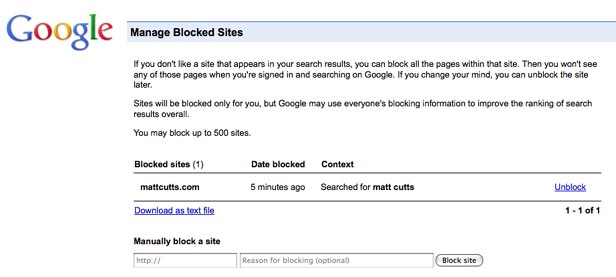Editor’s Note: The author of this post, Morris Rosenthal, runs Foner Books – a site which was heavily impacted by Google’s Panda update. WebProNews took a closer look at his story here. It’s an interesting look at how a legitimate author with seemingly high quality content, but perhaps not the most modern site design, took a big hit from the update. We don’t know that this is the primary reason, but Rosenthal offers his thoughts on this in the piece.
Do you think Google’s results are better post-Panda? Let us know in the comments.
I was still in college back in 1985 when the Coca-Cola Company changed their secret formula and launched the New Coke. The company had become concerned over competition from archrival Pepsi-Cola, especially with regard to locking in a new generation of brand loyal soda drinkers. So Coca-Cola created a sweeter formulation they hoped would appeal to young drinkers and embarked on extensive taste testing. Armed with incontrovertible evidence that the majority of soda drinkers preferred the new formulation over both Pepsi and the original Coke, the company discontinued their flagship drink and rolled out the New Coke. We all know the rest of the story.
After a decade of dominating the Internet search space with their eponymous Google search engine, the search quality engineers at Google began to worry about public discontent over search results. The complaint that grew louder and louder in the Internet community was the presence of Made For Adsense (MFA) sites winning top rankings in search. Adsense is the Google program that pays publishers to host advertising brokered by Google on their website. The bar for becoming an Adsense publisher is extremely low, so sites producing hundreds of thousands and millions of pages of meaningless garbage sprung up with the sole purpose of making quick money for their owners. Many MFA sites feature copyright infringements, scrapings of other web pages and low quality syndicated content.
So Google engineers concluded they needed a new way to provide consumers with relevant search results and began working on a search algorithm upgrade known as Panda. The goal of the Panda update was to introduce a quality filter for the search rankings based on, of all things, blind taste tests. While Google doesn’t share details about their internal engineering processes, they admit to recruiting hundreds of testers to grade a sample of web pages based on such criteria as, “Would you be comfortable giving this site your credit card?” and “Would you be comfortable giving medicine prescribed by this site to your kids?” I term this a blind taste test because Google gives no indication that their testers were asked to actually search for solutions to real problems and then judge the quality of the answers provided.
Next comes the tricky part. Google engineers tried to quantify how the scores they were already calculating for websites agreed with the quality judgments of their taste testers. By figuring out which parts of the score correlated with the winners of the website beauty pageant, they hoped discover a new recipe for relevant results. According to Google, the new weightings actually made sense when they looked at the results, and on February 23 of 2011 they rolled out the Panda update, creating a New Google.
Back in the Eighties when Coca-Cola was running their taste tests, it turned out that people chose the sweetest drink. Thanks to the efforts of search analysts who make a living monitoring Google results, we know what types of websites those Google testers chose. The sites that benefitted from the Panda update were a laundry list of brand names including: Amazon, Walmart, Wikipedia, Yahoo Answers, government websites and Sears.
And the how-to site so many searchers love to hate, eHow.com, was a surprising winner in an update that was intended to wipe out content farms. By employing hundreds of testers Google learned this important truth. Asked to grade random web pages, average people will trust those where they recognize the name or approve of the aesthetics. Slapping a familiar looking eCommerce template around a couple hundred words of scraped content is the Internet equivalent of adding sugar.
All of which would be small cocoa beans in the Internet world if not for the collateral damage caused by the Google update. Thousands of Mom-n-Pop websites, a sampling of which have been singled out for praise by universities, mainstream media, NGO’s and government agencies, have been given the heave-ho by Google with U.S. search traffic falling by 50% or more. The author of this article, whose homely Foner Books website was featured in a 2008 article about laptop repair in the New York Times, has seen U.S. Google traffic website fall by half. Many of the sites now appearing above the author’s site in Google search results are copyright infringements on the author’s work monetized with Google Adsense, and in many cases, those infringements have been syndicated to hundreds or thousands of other MFA sites.
Adding injury to insult, a Google search Laptop Repair Workbook, this author’s most popular eBook, now brings up a piracy directory in the #1 slot. Visitors to the piracy directory are randomly redirected to a fake anti-virus site that immediate tries to infect their computer.
Google spokespeople, in their public pronouncements, insist that the Panda update is a great success, and that consumers are happy with the new results. I haven’t seen any surveys, but I’ve been reading the sole web forum thread started by a Google employee for publishers who feel that their website has been unfairly treated by the update, and there are 750 votes against. There are also no replies from Google employees through any channel of communications.
Out in the broader world of discussion lists, publishers who were affected by the update often accuse those who weren’t impacted of drinking Google’s Kool-Aid. After fifteen years of writing and publishing online and off, it tastes more to me like the New Coke.
Have a post-Panda story? Share it in the comments.











